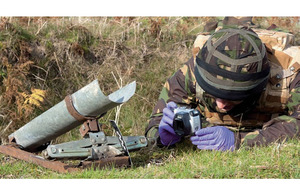New tri-Service intelligence unit formed to support Afghanistan operations
The brains behind some of the British Army's most complex counter-intelligence work have taken up a new role that will see them inform the final stages of Operation HERRICK. Report by Sarah Goldthorpe.

Recording evidence in the field [Picture: Steve Dock, Crown Copyright/MOD 2012]
2 Military Intelligence Battalion is now functioning as the British Armed Forces’ exploitation unit - a responsibility that puts the formation in charge of ensuring key enemy information is used to the military’s best advantage.
The tri-Service collective will focus on materiel and personnel exploitation in Afghanistan, getting troops onto the ground to assist the fight against IEDs while providing legally-sound evidence to the country’s justice system.
Speaking ahead of a flag-raising ceremony at the battalion’s new home in Trenchard Lines, Upavon, Captain Colin Joyce of the Intelligence Corps explained the challenge:
This unit has taken a number of our battalion’s forensic technical capabilities such as biometrics, fingerprinting and examination of media devices and weapons and put them under one roof.
This will help to provide a complete evidential picture of captured or suspected insurgents.
The new role appears to resemble something from the ‘Crime Scene Investigation’ (CSI) TV franchise and a short word with personnel indicates this analogy is not a million miles from the truth.
Lance Corporal Gary Atkinson, also of the Intelligence Corps, works within level one of the exploitation process.
Once deployed, it is his job to work alongside bomb disposal teams to collect pressure plates, battery packs, mobile phones, rifles or any other object recovered during patrols or incidents:
All devices come through us at some point,” Lance Corporal Atkinson explained, “so everything done at this level has to be forensically-sound; that means we wear gloves and face masks.
We will never touch anything IED-wise unless it has been cleared by the bomb disposal guys first, but it’s one of the few roles in the Intelligence Corps where you are out on the ground in the thick of the action and that’s exciting.
We go anywhere and everywhere in Helmand and never get bored.
Of the wide-ranging devices inspected by this team to garner war-winning information, something as inconspicuous as a battered Coke bottle can demand the CSI treatment.
Showing off one such drink receptacle complete with a deadly pull-switch, he said:
You will always find these types of devices out there because they are so easy to make.
Insurgents come up with different ways of using them - from ones with high metal content to those that can defeat detector capabilities.
As well as aiding the country’s legal system, consolidating the Army’s forensic facilities will ensure that lifesaving detail on enemy weapons can be fed to both front line troops and those back home developing protective kit:
We write reports on what we have found and run threat briefings to let battle groups and infantry commanders know the main dangers,” Lance Corporal Atkinson said.
We can also put out flash warnings if something new is discovered.
We like to look at it all like the military CSI but I am not sure it is quite as glam here as it is on the television screen.
Among the various forensics equipment used by soldiers in this role, the HazMat ID kit impresses its users every time.
Worth around £45,000, this unexciting-looking box can identify every single chemical component of a substance placed on its surface:
Even with coffee, this thing will tell you if it is caffeinated or decaffeinated,” Lance Corporal Atkinson boasted. “We know, we have tried!
In conflict, such substances could be the explosives or drugs that fuel the enemy:
This job is not just about weapons, it’s also the human element,” said Lance Corporal Peter Marsden, Royal Logistic Corps.
My role is getting out and collecting, but if guys at level two can bring DNA off whatever we find, we would want to know about that.
Personnel at the second and third levels of the exploitation process pull apart, download and dig into recovered articles to derive any information they can - be it DNA, geographical or technological intelligence.
Whether undertaken at the UK’s Defence Science and Technology Laboratory or further afield, their endeavours allow extensive data to be absorbed into the Army’s knowledge base.
Outlining the crucial counter-intelligence function of the new unit and its clever computers, Warrant Officer Class 2 Jonathan Webster of the Intelligence Corps said:
We can conduct exploitation of computers, networks and other aspects of the internet to get information, such as using social networks for example.
Opening up a compact case containing every mobile phone charger imaginable, he explained the unit’s ability to take call logs and texts off any model - even the fakes:
We process that information, for example who has called and when, and make links to key events to construct a picture of who is talking to who,” he added.
Unsurprisingly, this group’s efforts are not solely focused on the HERRICK mission.
While mobiles are pulled apart in the desert, other team members are busy keeping on top of technological advances that could aid future intelligence-gathering - fridges that connect to the internet, Kindles and the latest GPS equipment all hold possibilities.
But until 2014, the exploitation unit’s focus will remain firmly on Helmand province.
Commanding Officer Lieutenant Colonel Mark Proctor said:
We are concentrating on Afghanistan currently but looking to form training teams to teach other countries about exploitation as well.
We lend such a small number of people but are providing them 365-days-a-year.
Once we stop Op HERRICK, that allows us to move onto contingency, but for now it’s about making sure whatever we do is for the Afghans.
We need to keep lessons from Helmand province so that, wherever we go next, our unit is there from the beginning.
This article is taken from the February 2012 edition of SOLDIER - Magazine of the British Army.